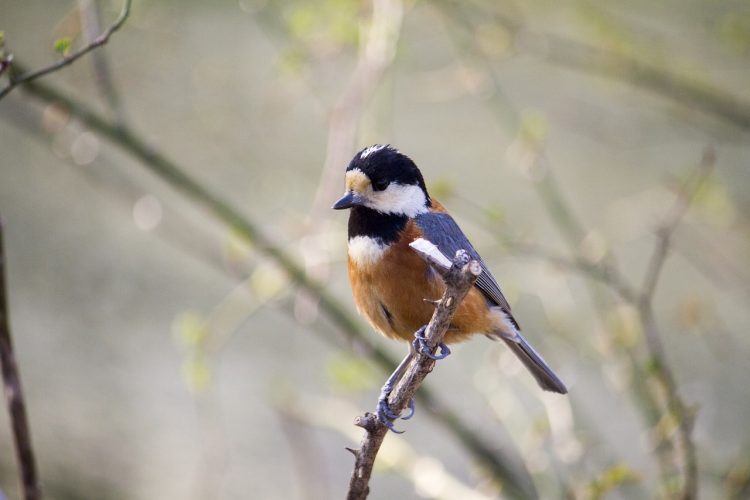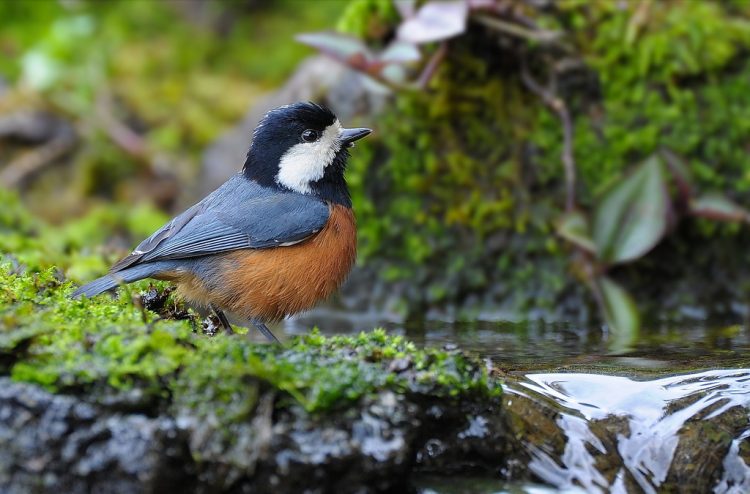Appearance:
The Varied Tit (Sittiparus varius) adult males and females are similar in plumage coloration. The head is black with a fine cream streak from the crown to the nape. The forehead and cheek are creamy white. The wings and tail are bluish-gray.
The throat and chest are black. The belly and back are orange-brown. However, Varied Tits vary considerably in plumage coloration between the subspecies. More southern subspecies may tend to be darker in plumage. Juveniles are drab in plumage color. They are milk-white on the abdomen, cheek, and forehead, and dark gray on the back.
Vocalization:
Varied Tits utter a nasal call like “Nee, nee”, “Tsweee”, etc. Their song sounds like “Tsoo-tsoo-bee, tsoo-tsoo-bee” with the accent on the third syllable. However, the vocalization varies considerably from one subspecies to another.

Distribution:
Varied Tits are distributed in Taiwan and the southern part of the Korean Peninsula as well as throughout Japan.
Habitat:
They primarily occur in broad-leaved evergreen forests (laurel forests in particular) from hills to mountains, but also inhabit a broad-leaved deciduous forest and a mixed forest of conifers and broad leaves.
Breeding System:
Varied Tits are socially monogamous. They maintain the pair-bond throughout the year, but frequently divorce and mate again. When they breed more than once in a season, they sometimes change their partners.

Nest:
Varied Tits nest in a tree cavity, but do not excavate their own nest hole and use an existing tree cavity. They often use artificial structures such as a nest box. They pile up moss in the bottom of a nest hole and lay fine plant fibers and fur for the inner cup.
They sometimes use synthetic fibers as an inner cup lining in suburban areas. There was a nest whose inner cup was lined with wild boar’s fur in the study site, but the nest stank of a beast, and the inner cup seemed uncomfortable because the fur was bristly.
Egg:
The typical egg is milk-white with reddish-brown flecks, but some birds lay eggs without flecks. According to the study conducted from 1998 to 2000 in Fukuoka City, southern Japan, the clutch size was 3-8 eggs with a mode of 4 eggs. However, life history characteristics, such as a clutch size are known to vary between populations or subspecies in Varied Tits.
Incubation, Nestling Periods and Fledging Rate:
The male does not incubate the eggs and feeds the female during the incubation period. It is assumed that the female mostly broods the nestlings as well right after hatching. The incubation period is about two weeks. The nestlings fledge about 16 days after hatching. Both parent birds feed the nestlings. The feeding frequency is not very high.
The author’s observation showed that the parents fed the young every 15 minutes even when they were 7-10 days old. In other words, a male or female parent feeds the nestlings every 30 minutes. The food consists primarily of the larvae and adults of Lepidoptera, and the sexes are roughly equal in feeding contribution. The nestlings rarely die of starvation and the breeding success was mostly determined by the predation of snakes, etc.
Topics of ecology, behavior, and conservation
Varied Tits include nine subspecies (Poecile varius varius, P. v. namiei, P. v. owstoni, P. v. orii, P. v. sunsunpi, P. v. yakushimensis, P. v. amamii, P. v. olivaceus, and P. v. castaneoventris). However, P. varius orii is assumed to be extinct. It is probably because the range consists mostly of many islands and the species is sedentary.
That the species has diverged into so many subspecies in a comparatively limited range composed of the Japanese Islands, the southern part of the Korean Peninsula, and Taiwan. As a matter of fact, no different subspecies occur sympatrically in large islands, such as the main islands of Japan, and therefore there is no doubt that the geographical isolation is principally responsible for Varied Tit
Sub Speciation
Varied Tit subspecies have a tendency to become darker in plumage coloration in southern areas. The subspecies distributed along the Izu islands (P. v. varius, P. v. namiyei and P. v. owstoni) become darker in plumage color, larger in body size, and smaller in clutch size in southern areas. It is still unknown, however, what evolutionary mechanism or effect of population genetics has given rise to geographic inclines of morphological and life-historical characters.
A Result of introgression
Individual variation among subspecies P. v. namiyei The author has studied the ecology of P. v. namiyei in Kozushima of the Izu Islands since 2003. This subspecies is distributed only in Toshima, Niijima and Kozushima of the Izu Islands, and sandwiched between P. v. varius distributed north of Oshima and P. v. owstoni distributed south of Miyakejima Island.
This subspecies is said to bear intermediate characteristics in morphology and life history between P. v. varius and P. v. owstoni, as if it reflects the geographic distribution. That is the case, but no study of the ecological and evolutionary mechanisms has been carried out yet. Among the results the author has found, it was especially interesting that P. v. namiyei varied in plumage coloration between individuals.
The typical plumage color is intermediate between those of P. v. varius and P. v. owstoni. The cheek is usually dark brown and the back is dark gray. However, the individual variation in cheek color was very large in Kozushima Island. The cheek ranged in color from creamy white as that of P. v. varius to dark brown. But no P. v. namiyei had a cheek as dark as that of P. v. owstoni. P. v. namiyei with a pale cheek is not P.v. varius that has come to Kozushima from the neighboring islands because the pale birds are larger than P. v. various and fall into the body size range of P. v. namiyei
It must be because P. v. namiyei is geographically sandwiched between P. v. various and P. v. owstoni that P. v. namiyei has these color variations in plumage. There are possible explanations for this phenomenon. (A) Hybridization between different subspecies has frequently occurred between Varied Tit subspecies in Kozushima, or (B) the genetic introgression has taken place between P. v. namiyei and P. v. varius and/ or P. v. owstoni.
Probably hybridization between different subspecies has not frequently occurred because the breeding of the typical P. v. owstoni and P. v. varius has not been confirmed in Kozushima. On the other hand, if P. v. varius and or P. v. owstoni even infrequently comes to Niijima or Kozushima and they breed with P. v. namiyei, then the genes of both or one of these subspecies will infiltrate into the population of P. v. namiyei.
The infiltrated genes will spread into the population of P. v. namiyei through the breeding of these subspecies. This phenomenon is called introgressive hybridization and has been reported in various animals. I suspect that this mechanism is partly responsible for the abundance of plumage color variations in P. v. namiyei.

Caching for the nestlings
Varied Tits are well-known for food caching behavior. When Varied Tits come to a bird feeder with sunflower seeds. They sometimes take the seed to a nearby branch and eat it there and sometimes fly away with the seed into a forest. When they take the seed into the forest, they probably cache it there.
It is known that birds with a habit of caching food can clearly remember where they have hidden their food. P. v. owstoni is assumed to have a more retentive memory because it is reported that this subspecies fed cached seeds to the nestlings the next spring.
In Aburayama Citizen’s Forest, Fukuoka Prefecture, southern Japan, on the other hand, many sunflower seedlings come out along a trail in the forest in spring. These seedlings suggest that although Varied Tits had cached sunflower seeds, they forgot to eat them or did not need to eat them because other food was in plentiful supply.
How heavily they depend on their cached food will be related to the abundance and constancy of food supply. It may be interesting to compare the relations between these habitat factors and food caching behavior as well as Spatio-temporal memories in various Varied Tit populations.







